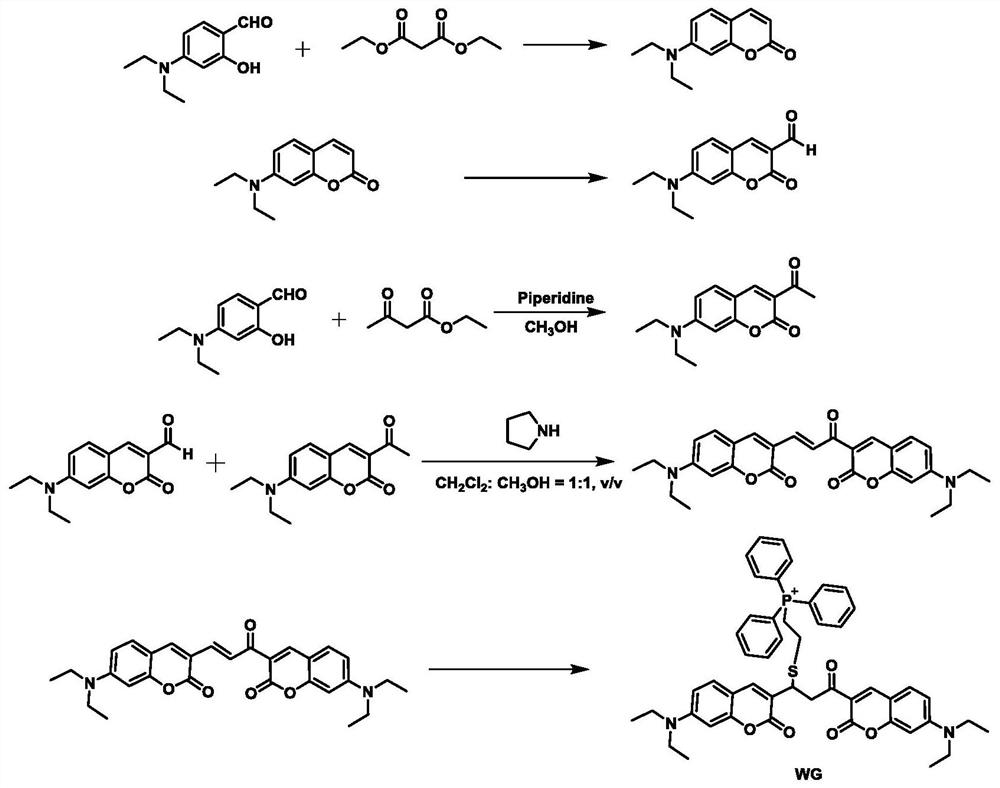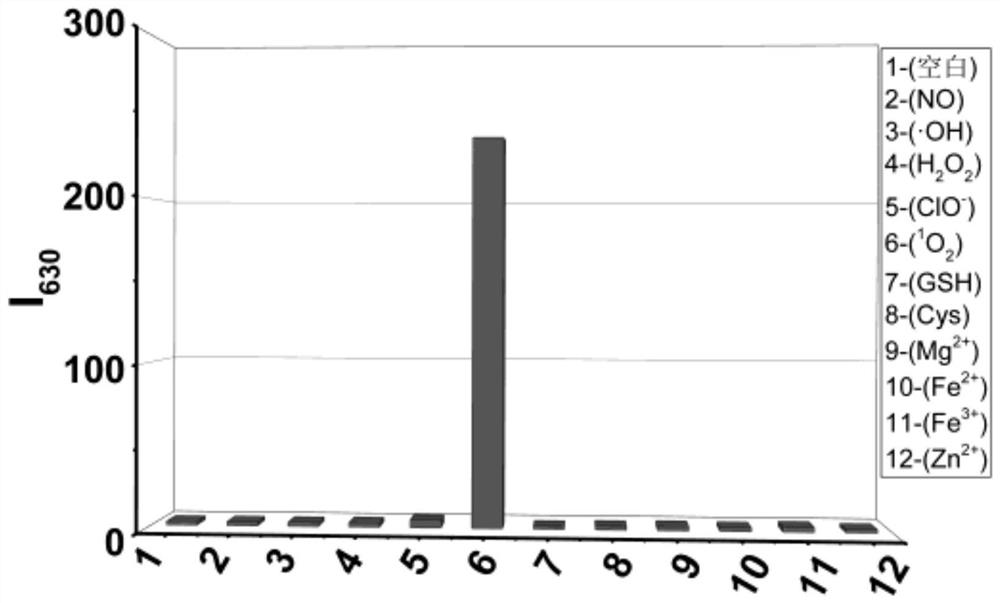Bifunctional fluorescent probe for detecting hypochlorite ion and/or singlet oxygen in cell mitochondria, preparation method and application thereof
A hypochlorite and singlet oxygen technology, applied in the field of fluorescence detection, can solve the problems of data confusion, different distribution and metabolic curves, and inability to respond to hypochlorite ions and singlet oxygen, so as to prevent side reactions and synthetic methods Simple and effective in reducing impurities that are difficult to separate
- Summary
- Abstract
- Description
- Claims
- Application Information
AI Technical Summary
Problems solved by technology
Method used
Image
Examples
Embodiment 1
[0065] Synthesis of fluorescent probes.
[0066] The preparation steps are summarized as:
[0067] Step 1, weigh 4-(diethylamino) salicylaldehyde and dissolve it in absolute ethanol, then add diethyl malonate, stir evenly, then add piperidine to obtain mixed solution A, mix the mixed solution AHeat to reflux and stir; after the reaction is completed, cool to room temperature, remove excess solvent, add an equal amount of acetic acid and hydrochloric acid in turn under ice-water bath conditions, and then continue to heat and reflux for reaction; after the reaction, pour the reacted mixture into In ice water, adjust the pH to 5 with sodium hydroxide solution, filter the precipitate under reduced pressure to obtain a filter cake, and recrystallize with absolute ethanol to obtain 7-(diethylamino)coumarin;
[0068] Step 2, at first prepare Wells reagent with equal amount of phosphorus oxychloride and DMF, then the 7-(diethylamino) coumarin that step 1 obtains is dissolved complete...
Embodiment 2
[0085] The fluorescent probe that embodiment 1 obtains is to hypochlorite ion (ClO - ) and singlet oxygen ( 1 o 2 ) detection selectivity.
[0086] Prepare the fluorescent probe molecule WG master solution with a concentration of 5 μM in methanol and set aside. Prepare a concentration of 1×10 with deionized water -3 M of H 2 o 2 , 1 o 2 , GSH, Cys, Mg 2+ , Fe 2+ , Fe 3+ , Zn 2+ solution, through the Fenton reaction to generate hydroxyl radicals (·OH). NO was generated using SNP (sodium(III) nitroferricyanide dihydrate). Use Na 2 MoO 4 / H 2 o 2 generated by the system 1 o 2 . When 300μM of various analyte solutions were added to the test solution containing 5μM fluorescent probe molecules (50mM phosphate buffer solution / methanol (1:4v / v, pH 7.4)), the probe WG (5μM) and Different analytes were incubated in the buffer solution for 30 minutes, and then the excitation wavelength was 480nm, and the fluorescence emission spectrum was measured to detect the respon...
Embodiment 3
[0091] Other common ions or molecules detect hypochlorite ion (ClO) to the fluorescent probe that embodiment 1 obtains - ) and singlet oxygen ( 1 o 2 ) interference experiment.
[0092] Prepare the test solution according to Example 2, first add 300 μM of other possible interfering substances to the 5 μM fluorescent probe molecule test solution, including blank, NO, OH, H 2 o 2 , 1 o 2 , GSH, Cys, Mg 2+ , Fe 2+ , Fe 3+ , Zn 2+ , and then added 300 μM hypochlorite ion (ClO - ). After mixing for 30 minutes, under the same conditions with excitation at 480nm, the fluorescence spectrum test was carried out to obtain the fluorescence spectrum of each group of solutions.
[0093] Prepare the test solution according to Example 2, first add 1.4mM of other possible interfering substances to the 5 μM fluorescent probe molecule test solution, including blank, NO, OH, H 2 o 2 , ClO - , GSH, Cys, Mg 2+ , Fe 2+ , Fe 3+ , Zn 2+ , and then add 1.4mM singlet oxygen ( 1 o 2 ...
PUM
 Login to View More
Login to View More Abstract
Description
Claims
Application Information
 Login to View More
Login to View More - R&D
- Intellectual Property
- Life Sciences
- Materials
- Tech Scout
- Unparalleled Data Quality
- Higher Quality Content
- 60% Fewer Hallucinations
Browse by: Latest US Patents, China's latest patents, Technical Efficacy Thesaurus, Application Domain, Technology Topic, Popular Technical Reports.
© 2025 PatSnap. All rights reserved.Legal|Privacy policy|Modern Slavery Act Transparency Statement|Sitemap|About US| Contact US: help@patsnap.com



